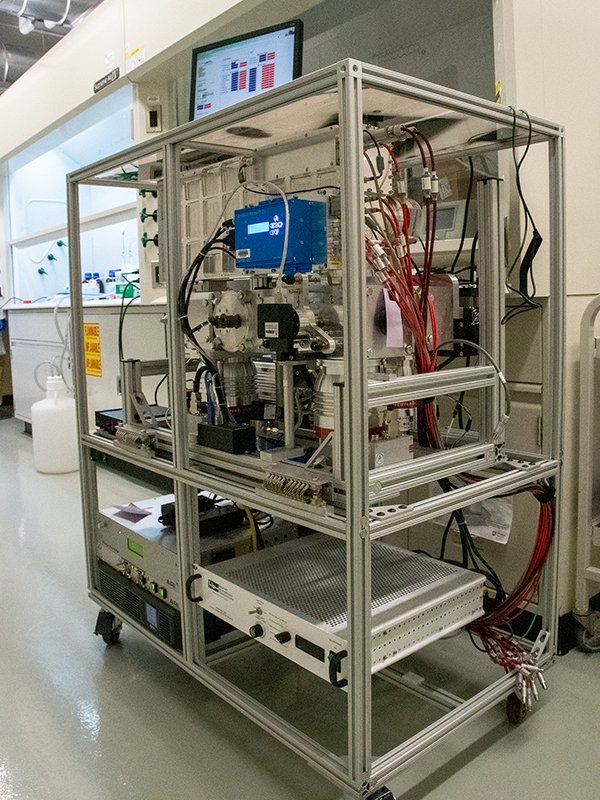
The Aerodyne aerosol mass spectrometer (AMS) is the only currently available instrument capable of providing quantitative size and chemical mass loading information in real-time for non-refractory sub-micron aerosol particles. The AMS couples size-resolved particle sampling and mass spectrometric techniques into a single real-time measurement system. The Aerodyne AMS has been deployed world-wide at fixed sites, and on mobile laboratory, ship and aircraft platforms. Over 100 instruments are in use in industrial, academic and government laboratories.
View Informational Webinar on TOF-AMS
Applications
- Measurement of ambient atmospheric aerosol mass loadings and size distributions for environmental monitoring.
- Emissions characterization of combustion sources. Direct determination of OC emissions indices with simultaneous measurement of plume CO2.
- Eddy correlation flux measurements of aerosol sulfate, nitrate, ammonium, and organic species dry deposition fluxes.
- High time-resolution mapping of fine aerosol properties from affordable mobile (van, small aircraft) platforms.
- Diagnostic for laboratory aerosol sources, flow reactors or aerosol chambers for aerosol physics and chemistry experiments.
- Analysis of chemical composition as a function of particle size for aerosol delivery systems such as metered dose inhalers. High time-resolution allows measurements on a puff-by-puff basis, eliminating need for time-consuming impactor analyses.
Using This Equipment
For more information and to utilize this equipment, please contact David Miller.
Advantages
- Mass spectrometric detection combined with particle time-of-flight provides information on particle aerodynamic diameter and aerosol composition in a single measurement.
- Quantitative chemical analysis by thermal vaporization and electron impact ionization mass spectrometry. Particle vaporization temperature adjustable from 200 C to 900 C. Laser-induced incandescence vaporization of black carbon under development.
- Real-time, quantitative size resolved aerosol mass measurement for non-refractory fine particulate matter (40 nm to ~1 µm). New inlets to transmit smaller and larger particle size ranges under development.
- Direct sampling of ambient aerosols; no filters or off-line chemical analysis necessary.
- Fast measurement (1 – 10 sec) of particle size distributions and non-refractory chemical composition. Maximum data collection rate of 100 Hz.
The High-Resolution TOF-AMS (HTOF-AMS) also enables continuous acquisition of complete mass spectra of individual particles, and enables the resolution of distinct chemical species based on mass defect.
| Detection Limit (µg/m3) | Mass Resolving Power (m/Δm) | Mass Range (m/z) | |
|---|---|---|---|
| HTOF-AMS (V-mode) | 0.003 | 2500 | 1-1200 |
| HTOF-AMS (W-mode) | 0.03 | 5000 | 1-1200 |
Physical Specifications
- Size: Approximately 41″W x 24″D x 50″H (HR-ToF-AMS)
- Weight: Approximately 320 lbs.
- Power: Approximately 600 Watts. Universal power 110VAC/60Hz or 220VAC/50Hz. Vacuum system fully operational on 24 VDC.
AMS Features
Efficient Particle Time of Flight Module
It includes:
- An improved particle sizing module
- An improved data acquisition card
The sizing module, referred to as the efficient particle time of flight (ePTOF) chopper is based on a multiplexed particle beam chopper system with 50% particle throughput (compared to 2%) providing significantly improved signal-to-noise for the particle size measurement.
SP-AMS
The Soot Particle Aerosol Mass Spectrometer (SP-AMS) makes real-time, in situ measurements of black carbon containing particles. The SP-AMS uses laser-induced incandescence of absorbing soot particles to vaporize both the coatings and elemental carbon cores within the ionization region of the AMS, providing a unique and selective method for measuring the mass of the refractory carbon cores (i.e., black carbon mass), the mass and chemical composition of any coating material (e.g,. organics, sulfates, nitrates, etc.), and particle size and morphology.
The SP-AMS has been deployed in several field campaigns for measurements of ambient aerosol (Queens, NY, 2009), biomass burning plumes (FLAME III, 2009) and ship plumes (CalNex 2010).
Works Cited
- Ambient Aerosol Sampling with an Aerosol Mass Spectrometer, J. L. Jimenez, J. T. Jayne, Q. Shi, C.E. Kolb, D.R. Worsnop, I. Yourshaw, J.H. Seinfeld, R.C. Flagan, X. Zhang, K.A. Smith, J. Morris, and P. Davidovits, J. Geophys. Res. – Atmospheres, 108, (D7), 8425, doi:10.1029/2001JD001213, 2003.
- A new Time-of-Flight Aerosol Mass Spectrometer (ToF-AMS) – Instrument Description and First Field Deployment, F. Drewnick, S.S. Hings, P.F. DeCarlo, J.T. Jayne, M. Gonin, K. Fuhrer, S. Weimer, J.L. Jimenez, K.L. Demerjian, S. Borrmann, D.R. Worsnop. Aer. Sci. Technol., 39, 637–658, 2005.
- A Field-Deployable High-Resolution Time-of-Flight Aerosol Mass Spectrometer, P. F. DeCarlo, J.R. Kimmel, A. Trimborn, M.J. Northway, J.T. Jayne, A.C. Aiken, M. Gonin, K. Fuhrer, T. Horvath, K. Docherty, D.R. Worsnop, and J.L. Jiménez, , Anal. Chem., 78, 8281-8289, 2006.
- Chemical and Microphysical Characterization of Ambient Aerosols with the Aerodyne Aerosol Mass Spectrometer, M.R. Canagaratna, J.T. Jayne, J.L. Jiménez, J.D. Allan, M.R. Alfarra, Q. Zhang, T.B. Onasch, F. Drewnick, H. Coe, A. Middlebrook, A. Delia, L.R. Williams, A.M. Trimborn, M.J. Northway, P.F. DeCarlo, C.E. Kolb, P. Davidovits, and D.R. Worsnop, Mass Spectrom. Rev., 26, 185-222, 2007.
